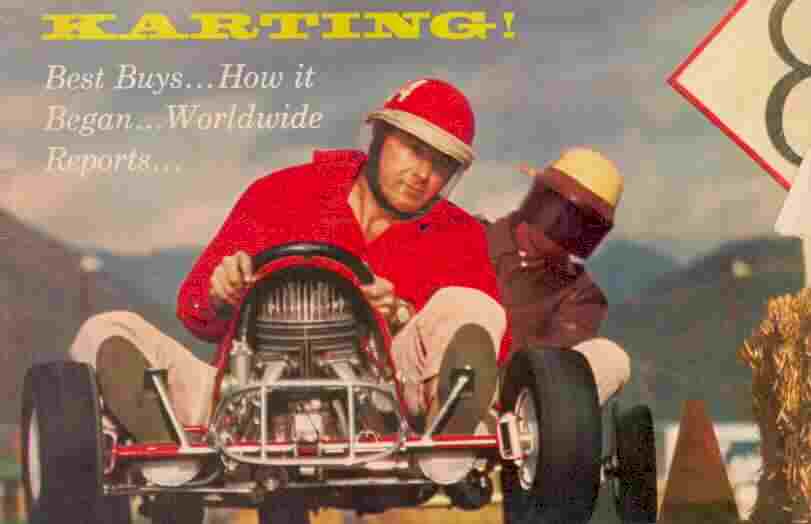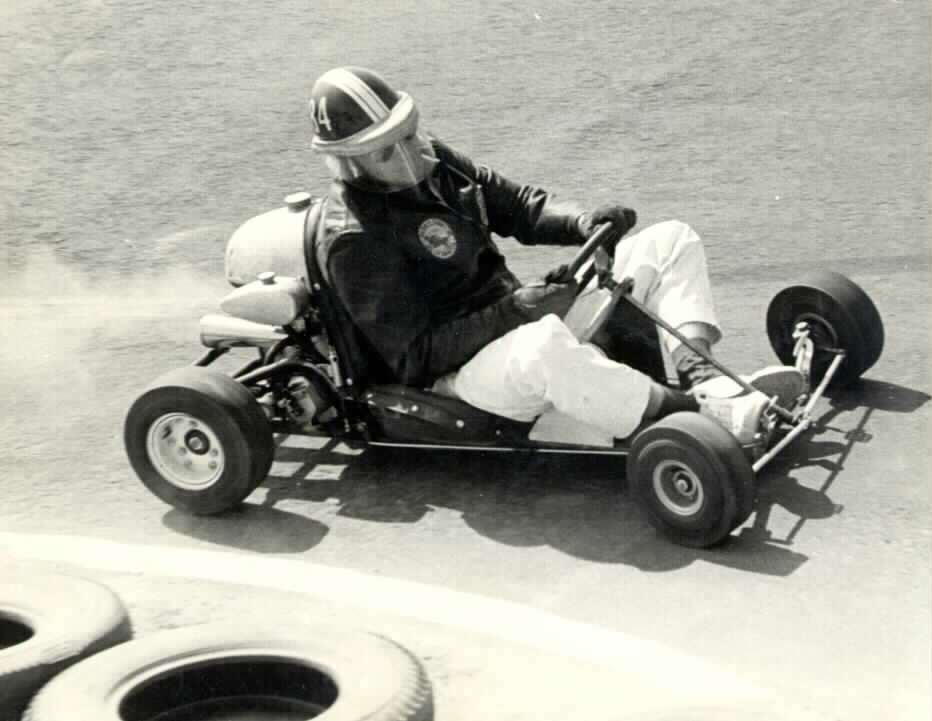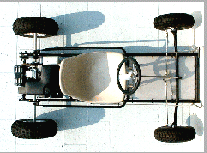

About the photo: Duffy Livingstone, who co-founded the Go Kart Mfg Co. in 1957, and to this day is referred to as the "Father of Karting", is pictured here on the cover of Motor Trend magazine, April 1960. The wild machine he is driving is his own hand-built creation powered by a front-mounted Puch motorcycle engine. Just behind him in the photo is karting pioneer Don Boberick who you may recognize as the contributing author of this web site's "History" section.
Alright. Let's turn back the clock!
It's 1960, you've just purchased your first kart and you want to go
racing. Take some tips from karting pioneer and ace driver Duffy Livingstone as he
explains, in this imaginary interview (based on actual comments made in various real
interviews), some of the elements of his driving style.
One of the acknowledged best drivers in karting today [remember, it is now 1960 as you are reading this - Ed.] is Duffy Livingstone, one of the originators of the sport, a co-owner of one of the larger kart manufacturing firms, head of the Go Kart Racing Team, and Chairman of the Competition Committee of the GKCA (Go Kart Club of America). Duffy has a driving style all his own - in fact, a good many people who attend the bi-monthly events at the Go Kart Raceway (in Azusa, California) come solely to watch Duffy handle any of the several karts he regularly drives.
(Photo from Duffy's personal archive.)
Duffy's secret lies in his knowledge of his machine's capabilities - and staying within
them! - combined with a completely relaxed attitude which makes it easy for him to alter
course if called upon to do so at the last split second. He never allows himself to get
into a position where his muscles are so tensed that he couldn't negotiate an alternate
maneuver if necessary.
Equally as important to Duffy as the route he intends to take through a particular turn are the competitors both behind and ahead of him. If, for example, he is sufficiently ahead of a following kart that it couldn't possibly present a hazard to him, then he forgets all about it when cornering. He doesn't waste time worrying if someone is going to pass him when he knows that no one is. It may sound strange, but many drivers - especially when leading a race - look back over their shoulders to see who's in second place. Then they wonder why they spun out when the race was in the bag! If another kart is hot on your heels, it pays to keep track of his position, but if it's several lengths back, then forget it and concemtrate on your own driving.
Many drivers report that they can really handle their karts when they're not right behind another car. Put them a few feet behind another competitor in a race and they just about lose control on every turn. One reason for this is they are concentrating on the other person's driving instead of their own. They see the guy in front get set for a turn and they automatically do the same thing at the same time. As a result, they are turning several feet before they should. Too, the second car will often follow the path of the first instead of staying in his own groove. If the kart in front isn't taking the line you generally follow, don't get right behind and do what he does. His kart may handle differently from yours, or he may just be taking a poor line.This is where a slower kart can often beat a faster one - by its driver taking the only correct route through a particular turn for his particular car.
Adapting to different karts
Duffy can take a stranger's kart and make it do things even the owner with perhaps months of experience behind the wheel could not do. But you'll never catch duffy doing it on his first or even his second lap. He will ease the unfamiliar kart around the course, sensing its balance, feeling out its steering and telling through his seat-of-the-pants style at about what speed either the front or rear end will begin to "wash out". Then he'll take each successive lap at a slightly faster pace. Within minutes, he can easily equal the owner's fastest lap times and often better them.
Where to focus
We asked Duffy where he looked while negotiating a particularly tricky turn - one with which he was not too familiar. He replied, after thinking it over, that he wasn't sure and went out on the course to find out for himself. After a few laps, he pulled in and said he was concentrating so hard on where he was looking that he nearly went off the course.
We persisted in the line of questioning about visual concentration and asked whether he ever kept his eyes on the front wheels to see which way they were pointing. He thought no, since steering is only a reflex action demanded by the brain. But to find out for sure, he took a couple laps on an unusual kart which had its seat so far forward that the front wheels were hidden by Duffy's akimbo knees. After a few laps, he reported that he couldn't drive the thing at all - he couldn't see the wheels! Reflecting on this for a moment, he reasoned that keeping the front wheels in view on a corner is especially necessary, but that they mustn't be stared at to be seen. You're conscious of them even when you are looking yards ahead.

Duffy is one of the most photographed of all kart drivers
(Photo from Duffy's personal archive.)
An intuitive style!
Duffy's is strictly an intuitive driving technique, but he is one of those rare handlers where sheer instinct leads him to do the things that he does. He often enters a turn with the car pointing in the direction it should be in after the turn has been completed - sometimes unnerving to following drivers! His somewhat mystifying explanation is that as long as you're not doing anything when going down a straightaway, you might as well go through the turn. Then when you get to the turn, you don't have to worry about making it. (I think Duffy likes to have some fun at the expense of us intervewers! Alright, we'll quit bugging you, Duff, and let you get back to racing.)
Build your own classic style kart!!
